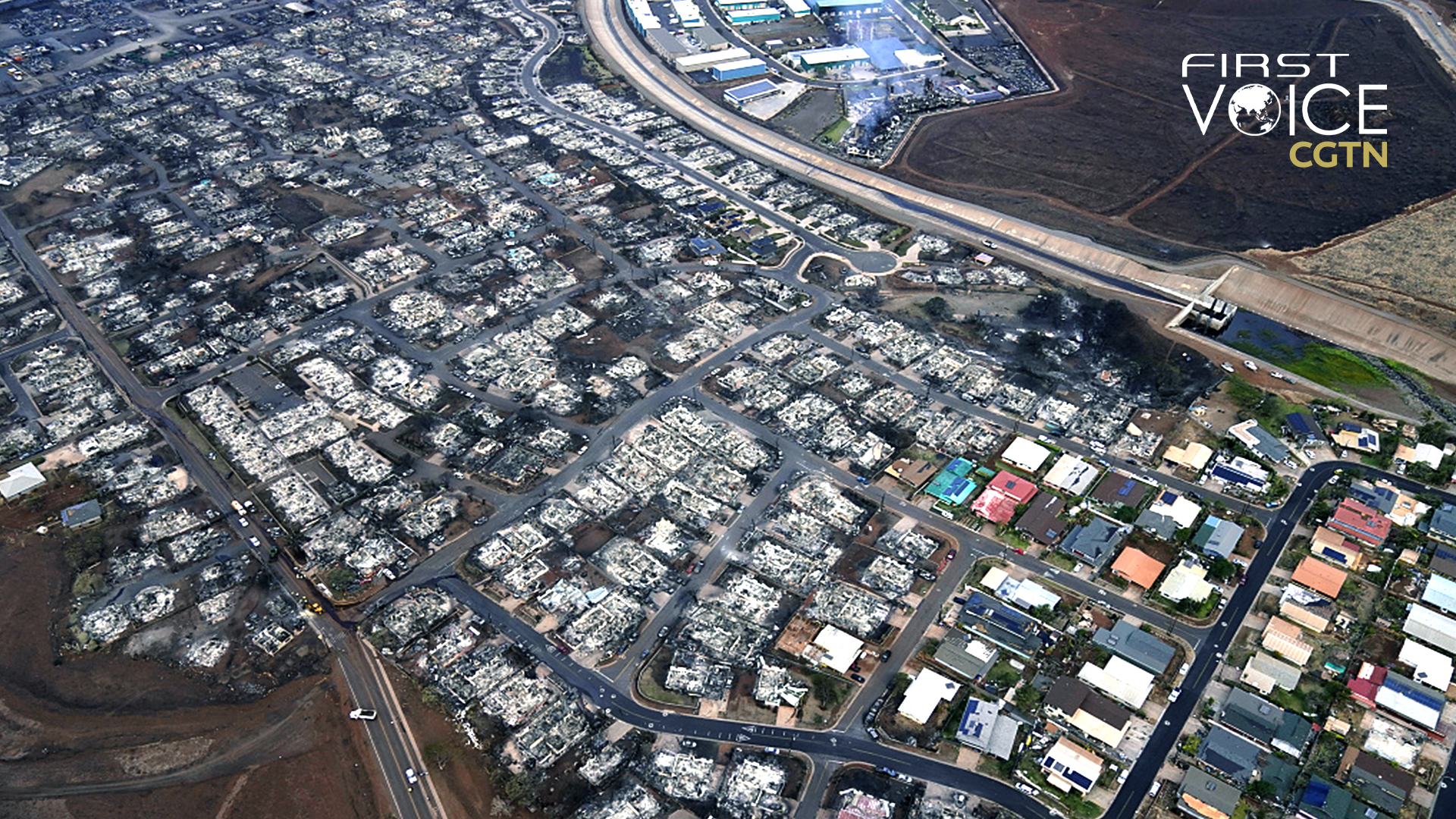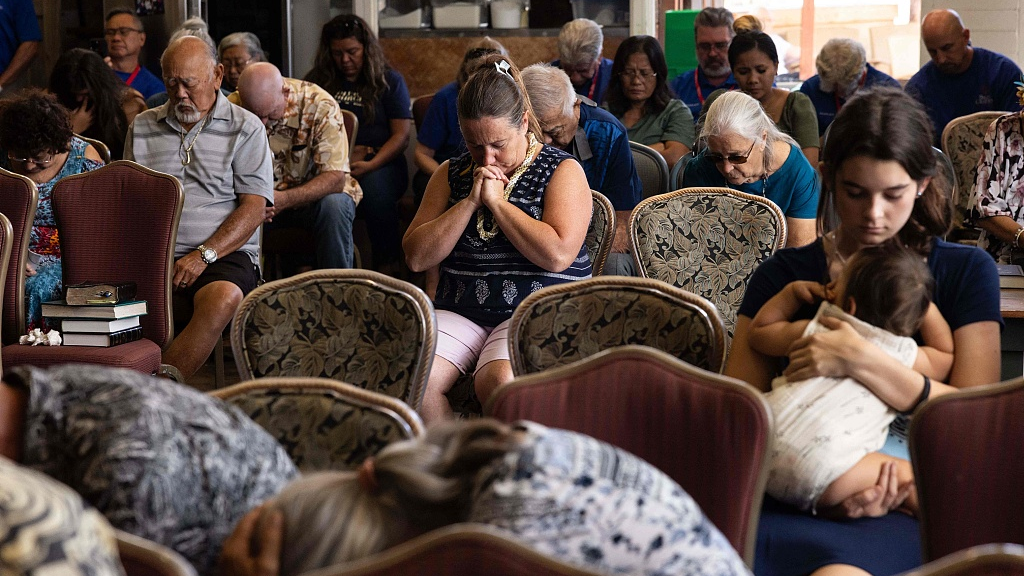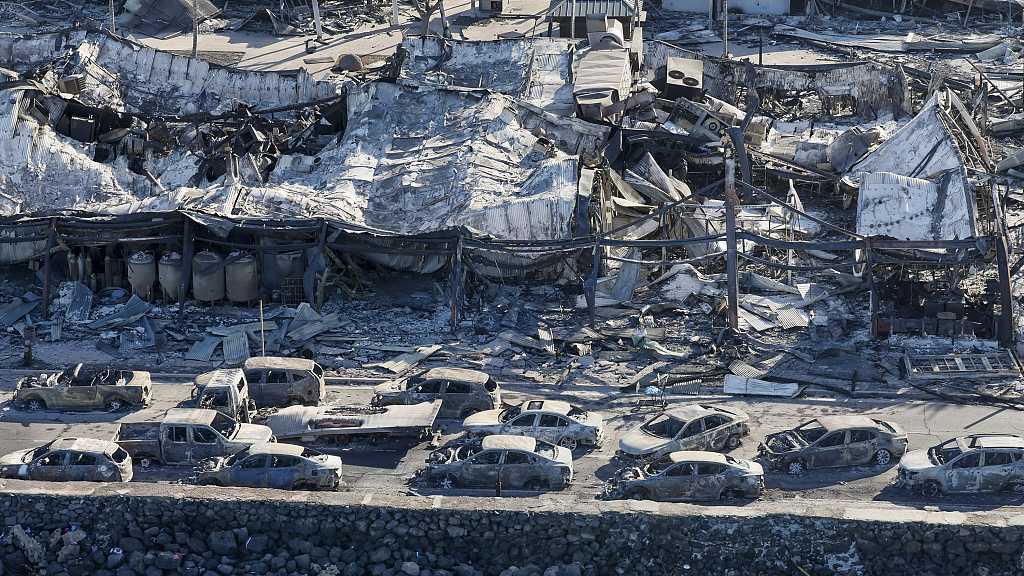
Wildfire wreckage is seen in Lahaina, Maui, Hawaii, United States, August 10, 2023. /CFP
Wildfire wreckage is seen in Lahaina, Maui, Hawaii, United States, August 10, 2023. /CFP
Editor's note: CGTN's First Voice provides instant commentary on breaking stories. The column clarifies emerging issues and better defines the news agenda, offering a Chinese perspective on the latest global events.
114 people dead and over 1,000 missing, the fire in Maui, Hawaii, that ignited around 10 days ago has become the U.S.'s deadliest in over a century. The heavy casualties and the "doomsday" scenes in the ruined island town of Lahaina is reminiscent of Hollywood disaster movies. But after investigation, the unknown causes of the Maui blazes have been illuminated.
Although most houses on Maui were burned to ashes, as we could see in aerial photos, there are surprisingly a few homes that have survived the wildfire of the century in contrast to the surrounding ruins.
This seems strange at first, but the reason is simple. The surviving villas, mainly owned by the rich, are entitled to relatively superior infrastructure and services, so they managed to escape the catastrophe, while native Hawaiians complained that most residents on the island still use the infrastructure that is in disrepair.
Native Hawaiians were historically regarded as "second-class citizens" by the authorities. Kekoa Lansford, who lost his home in the fire, told NBC News that the locals' demands for upgrading basic living facilities has rarely been addressed.
It's even more unbelievable that while the search for missing persons in the fire is still underway, real estate developers from the continental U.S. are ready to take advantage of the disaster, acquiring survivors' properties for land development.

Survivors and churchgoers pray during a Sunday church service at Maui Coffee Attic in Wailuku, central Maui, Hawaii, United States, August 13, 2023. /CFP
Survivors and churchgoers pray during a Sunday church service at Maui Coffee Attic in Wailuku, central Maui, Hawaii, United States, August 13, 2023. /CFP
The aging power grid is a main contributor to this tragedy of the century as burnt black wooden utility poles can be seen everywhere in the ruins. It's shocking that the U.S. – a country capable of manufacturing the most advanced weapons in an age of advanced technology – still resorts to wooden utility poles on its territory.
Hawaiian Electric was "grossly negligent by making conscious decisions to delay grid modernization projects that would have prevented this very tragedy," attorney Mikal Watts said in an interview with NBC News. The power company is facing multiple lawsuits from the residents.
In 2018, the "largest fire in Maui's history" sparked by a downed utility pole had burned 2,000 acres and devoured over 20 homes, after which rebuilding projects including various electrical equipment modernizations were under discussion; yet the company hasn't invested much in pole upgrades or wildfire prevention in the years since.
Hawaii wildfires are just the tip of the iceberg. Across the United States, there remain tens of thousands of wooden poles in the power grid, with over 70 percent of the transmission lines and transformers in operation for more than 25 years, and 60 percent of the circuit breakers in operation for more than three decades. Old lines make these infrastructures more prone to problems in the face of extreme weather.

An aerial view of Lahaina after a wildfire gutted the area, Lahaina, Maui, Hawaii, United States, August 11, 2023. /CFP
An aerial view of Lahaina after a wildfire gutted the area, Lahaina, Maui, Hawaii, United States, August 11, 2023. /CFP
The pursuit of commercial interests, ineffective management and neglect of repairs also laid the hidden dangers for the fire early. In an interview with Democracy Now, a seventh-generation Native Hawaiian, former Congressman Kanila Inge, complained that after the former colonists seized the land, the modern developers – in order to build tourist facilities such as golf courses and hotels – exploited local resources, destroyed vegetation and the ecological environment, and drew water from wetlands for corporate investment projects.
Moreover, the federal government didn't manage invasive species like geranium effectively after their introduction to Hawaii. These flammable weeds, combined with drier conditions in parts of the islands in recent years, have made wildfires more likely, according to Clay Trauernicht, a tropical fire researcher at the University of Hawaii at Manoa.
Among the over 100 dams in Hawaii, many have been neglected and in disrepair for a long time, which has reduced the state's ability to store increasingly scarce rainwater that could be used to irrigate land and improve its fire resistance, said Jonathan Scheuer, an expert in Hawaii water policy.
Faced with the most basic questions from locals and media about the cause of the U.S.'s deadliest fire in over a century, the failure of the early warning system, and the delay in rescue, the government and the police are giving irrelevant answers. The fire that destroyed homes on Maui is a testament to the failure of public utilities, the government's capacity to respond, and its disregard for the safety of people.
This can't help but make people sigh: The U.S. claims to be a beacon of human rights, concerned about other countries' affairs, but why does it ignore its own people?
(If you want to contribute and have specific expertise, please contact us at opinions@cgtn.com. Follow @thouse_opinions on Twitter to discover the latest commentaries in the CGTN Opinion Section.)